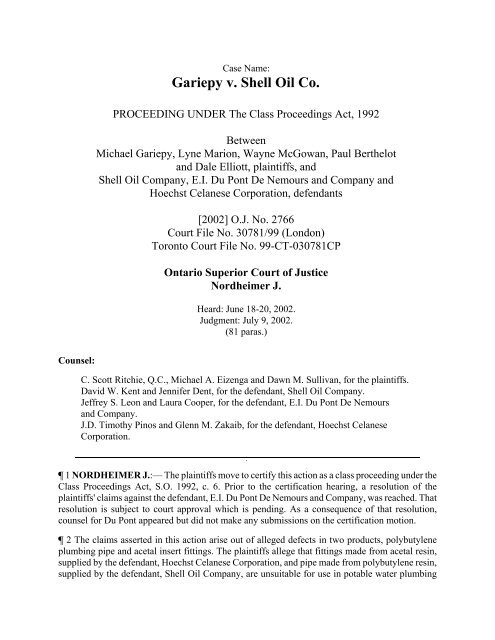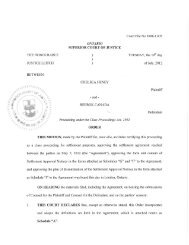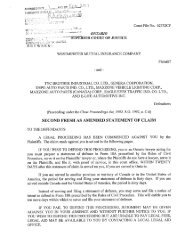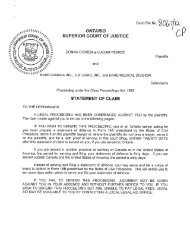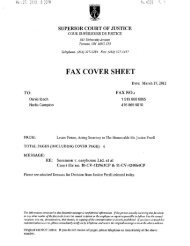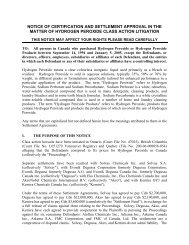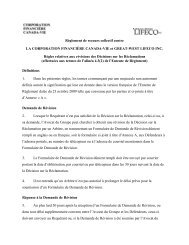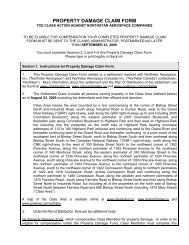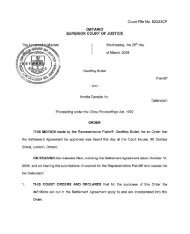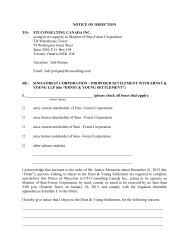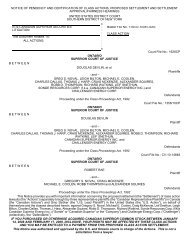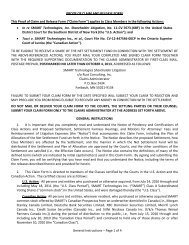Gariepy v. Shell Oil Co. - Classaction.ca
Gariepy v. Shell Oil Co. - Classaction.ca
Gariepy v. Shell Oil Co. - Classaction.ca
You also want an ePaper? Increase the reach of your titles
YUMPU automatically turns print PDFs into web optimized ePapers that Google loves.
Case Name:<strong>Gariepy</strong> v. <strong>Shell</strong> <strong>Oil</strong> <strong>Co</strong>.PROCEEDING UNDER The Class Proceedings Act, 1992BetweenMichael <strong>Gariepy</strong>, Lyne Marion, Wayne McGowan, Paul Berthelotand Dale Elliott, plaintiffs, and<strong>Shell</strong> <strong>Oil</strong> <strong>Co</strong>mpany, E.I. Du Pont De Nemours and <strong>Co</strong>mpany andHoechst Celanese <strong>Co</strong>rporation, defendants[2002] O.J. No. 2766<strong>Co</strong>urt File No. 30781/99 (London)Toronto <strong>Co</strong>urt File No. 99-CT-030781CPOntario Superior <strong>Co</strong>urt of JusticeNordheimer J.Heard: June 18-20, 2002.Judgment: July 9, 2002.(81 paras.)<strong>Co</strong>unsel:C. Scott Ritchie, Q.C., Michael A. Eizenga and Dawn M. Sullivan, for the plaintiffs.David W. Kent and Jennifer Dent, for the defendant, <strong>Shell</strong> <strong>Oil</strong> <strong>Co</strong>mpany.Jeffrey S. Leon and Laura <strong>Co</strong>oper, for the defendant, E.I. Du Pont De Nemoursand <strong>Co</strong>mpany.J.D. Timothy Pinos and Glenn M. Zakaib, for the defendant, Hoechst Celanese<strong>Co</strong>rporation. 1 NORDHEIMER J.:— The plaintiffs move to certify this action as a class proceeding under theClass Proceedings Act, S.O. 1992, c. 6. Prior to the certifi<strong>ca</strong>tion hearing, a resolution of theplaintiffs' claims against the defendant, E.I. Du Pont De Nemours and <strong>Co</strong>mpany, was reached. Thatresolution is subject to court approval which is pending. As a consequence of that resolution,counsel for Du Pont appeared but did not make any submissions on the certifi<strong>ca</strong>tion motion. 2 The claims asserted in this action arise out of alleged defects in two products, polybutyleneplumbing pipe and acetal insert fittings. The plaintiffs allege that fittings made from acetal resin,supplied by the defendant, Hoechst Celanese <strong>Co</strong>rporation, and pipe made from polybutylene resin,supplied by the defendant, <strong>Shell</strong> <strong>Oil</strong> <strong>Co</strong>mpany, are unsuitable for use in potable water plumbing
systems. The plaintiffs allege that if such fittings and piping are used in potable water plumbingsystems, they will fail prematurely leading to leaks and damages consequent on such leaks. 3 The defendants assert that their materials are suitable for use in the manufacture of products thatare, in turn, used in potable water plumbing systems and that any leaks that are experienced bymembers of the putative class arise from other factors such as manufacturing defects, installationerrors, rodents chewing holes in the pipe, nails being driven into the pipe or improper maintenance. 4 The plaintiffs assert <strong>ca</strong>uses of action including negligent design, failure to warn,misrepresentation and breach of warranty. The plaintiffs have sued only the raw materialmanufacturers. They have not sued the companies that manufactured the pipe or the fittings. Theyhave also not sued house builders or plumbers who chose and installed the plumbing components. 5 The proposed class is defined in the plaintiffs' factum as:All owners of residential dwellings in Ontario who have or had a "polybutyleneplumbing system" in their residence which is or was composed of polybutylene pipeor polybutylene pipe and insert acetal fittings manufactured from materials sold andsupplied by the defendants. "Polybutylene plumbing system" refers to water supplyplumbing containing pipes fabri<strong>ca</strong>ted, in whole or in part, from polybutylene, andinsert fittings, including tees, inserts, elbows, couplings, fabri<strong>ca</strong>ted in whole or inpart, from Celcon acetal resin, whether sold and/or installed as a system or asseparate pieces.Each of the proposed representative plaintiffs claims damages of $60,000 together with punitivedamages of $1,000,000. The plaintiffs suggest that there are thousands of homeowners in Ontariowho would fall within this definition of the class. However, it is apparent that, at this stage of theproceedings, no precise estimate of the size of the proposed class <strong>ca</strong>n be made. In addition to thisaction, there are parallel proposed class actions filed and being pursued in British <strong>Co</strong>lumbia (Furlanv. <strong>Shell</strong> <strong>Oil</strong>), and in Quebec (<strong>Co</strong>uture v. <strong>Shell</strong> <strong>Oil</strong>), neither of which has yet reached the certifi<strong>ca</strong>tionstage.Background 6 This action was commenced by Statement of Claim on February 18, 1999. <strong>Shell</strong> is a Delawarecorporation with its principal place of business in Texas. <strong>Shell</strong> manufactured polybutylene resinwhich was in turn fabri<strong>ca</strong>ted by others into plumbing pipes. Du Pont is a Delaware corporation withits principal place of business in Delaware. Celanese is a Delaware corporation with its principalplace of business in New Jersey. Du Pont and Celanese manufactured acetal resins (under the brandnames Delrin and Celcon respectively) which were fabri<strong>ca</strong>ted by others into fittings. 7 The plaintiffs allege that the polybutylene plumbing systems are failing or will fail prematurelyas a direct result of the material used to make the components of the subject polybutylene plumbingsystems. The plaintiffs allege that the material which was designed, developed, manufactured andsold by the defendants to be used as an integral part of these polybutylene plumbing systems isinappropriate for use in potable water plumbing systems. The plaintiffs allege that use of thismaterial represents a design defect in that the material itself is a criti<strong>ca</strong>l element of the design ofthese systems for which the defendants are liable. The plaintiffs also allege that the defendants failed
to adequately test their products and in all the circumstances were negligent in failing to properlywarn class members of the limitations of PB plumbing systems. 8 The issues raised by this action have been the subject of proceedings in the United States formany years. It appears that very few of those actions, however, have been certified as class actionsand none of those certified have been certified on either a state-wide or nationwide basis. It shouldbe noted, however, that in 1995, <strong>Shell</strong> and Celanese entered into a settlement with a nationwide classof homeowners in Tennessee in <strong>Co</strong>x v. <strong>Shell</strong> <strong>Oil</strong> <strong>Co</strong>mpany 1995 WL 775363 (Tenn.Ch.). At aboutthe same time, Du Pont entered into a second nationwide class settlement in Alabama state court inSpencer v. <strong>Shell</strong> <strong>Oil</strong> <strong>Co</strong>mpany (unreported, Cir. Ct. of Greene <strong>Co</strong>unty, Alabama, June 30, 1995).These settlements were made expressly without any admission of liability and, in particular, withoutconceding that certifi<strong>ca</strong>tion of such claims was appropriate. 9 Plastic pipe made from polybutylene resin has two primary potable water appli<strong>ca</strong>tions. One isfor use in cold water service, including underground pipe for transmitting potable water from amunicipal line to a residential or commercial building; and the other is for use in plumbing service,consisting of pipe used inside a residential or commercial structure to <strong>ca</strong>rry both hot and coldpotable water to plumbing fixtures. Not all plumbing pipe is plastic, and not all plastic plumbingpipe is made from PB. <strong>Co</strong>mmercial and residential structures will contain plumbing pipes made ofone or more of not only PB, but also copper, chlorinated polyvinyl chloride ("CPVC"), cross-linkpolyethylene ("PEX") or galvanized steel. The supply lines may be made from PB, copper,polyethylene ("PE"), PEX, flex metal or nylon or other flexible plastics. Yard service lines may bemade of PB, copper, PVC, PE, PEX or galvanized steel. 10 There are also many different designs of fittings, made from a variety of materials, which maybe used with PB plumbing pipe. Many structures will use more than one kind or style of fitting withtheir PB pipes. For example, PB pipe may be joined using fittings made from metal (primarilycopper and brass), acetal, PB, polysulfone, polypropylene, CPVC, PVC or a combination of metaland plastic. Indeed, in this <strong>ca</strong>se, the representative plaintiffs have a variety of fittings in their houses. 11 Neither <strong>Shell</strong> nor Celanese have ever commercially manufactured, designed, sold or installedPB pipe, fittings or any kind of plumbing systems. Both of these companies simply made resins inpellet form which they sold in bulk to unrelated companies. These companies then designed andextruded various sizes and types of plastic pipe or designed and manufactured various types offittings or both. The pipe and/or fitting manufacturers sold the pipes and fittings into themarketplace, often through distributors. 12 PB pipe, and the fittings used to join PB pipe, were designed, extruded, moulded, distributedand/or manufactured by a wide variety of companies. Each manufacturer designed and implementedits own extrusion process using its own equipment, and these designs and processes varied a greatdeal. The manner in which the extrusion process is designed and performed <strong>ca</strong>n affect the qualityand ultimate performance of the pipe. 13 PB plumbing installations varied according to the instructions followed by, the tools used by,the techniques and practices employed by, and the relative skill and experience of each of the manyinstallers in Canada. PB pipe and acetal fitting manufacturers and resellers variously provided eithertheir own individual instruction guidelines or standardized guidelines prepared by the Plastic Pipe
and Fittings Association from time to time. A variety of types and models of crimping tools wereused and were manufactured by different companies at different times. Installation errors, includingin particular improper installation of fittings and over bending or misplacing PB pipe, <strong>ca</strong>nsignifi<strong>ca</strong>ntly impair the performance and longevity of the plumbing system in question. 14 As may be self-evident from the nature of the ultimate products, and as courts in the UnitedStates have found, there is no single universal "polybutylene plumbing system". Most plumbingsystems are planned in an ad hoc manner by plumbers performing the installations using whatevercomponents are readily and economi<strong>ca</strong>lly available. There will, of course, be considerable variabilityin the construction and design of the different types of structures into which such systems areinstalled and, consequently, the combination of components and the manner of their installation willvary greatly. The ultimate, and again perhaps self-evident, consequence of these facts is that thereare many different reasons why any plumbing system may fail, that is leak, including failures in theproducts, the design, the manufacturing, the installation and the maintenance of the system. Further,some leaks which initially may be blamed on the system <strong>ca</strong>n in fact be the result of problems withfixtures such as faucets and toilets. Finally, leaks may manifest themselves in many different ways:they may be pipe leaks (i.e., splits or holes in the pipe); leaks at the joints where the pipes andfittings are connected; leaks resulting from pipes and fittings coming loose or separating at thejoints; leaks resulting from cracked, corroded or loose crimp rings; leaks resulting from crackedfittings; leaks from rodents chewing through the pipe; leaks <strong>ca</strong>used by an installer or homeownerabusing the plumbing (e.g., putting a nail through the pipe); or any combination of these types ofleaks. The determination of the source and type of leak <strong>ca</strong>n only be made after an examination ofthe individual plumbing system. 15 It will not likely come as a surprise to anyone that there is a dispute among the parties' variousexperts on the suitability of the defendants' products for use in polybutylene plumbing. Theplaintiffs' principal experts are Dr. Stivala and Dr. Chudnovsky. Dr. Stivala is a research professorin chemistry from the United States and has spent considerable time in the research of polymers. Heopines that the common <strong>ca</strong>use of failure of acetal fittings and PB pipe is susceptibility of the materialto chemi<strong>ca</strong>l attack in potable water. Specifi<strong>ca</strong>lly, oxidative degradation occurs as a result of thepresence of oxygen, and other oxidizing agents including chlorine, in potable water. Dr. Stivala isof the view, therefore, that the defendants' resins are inappropriate for use in potable water systems.Dr. Chudnovsky is a professor of mechanics and materials from the United States who has spentconsiderable time researching the long-term strength of materials. He gives the opinion that PB pipeand acetal fittings are inherently susceptible to mechano-chemi<strong>ca</strong>l degradation in an aqueousenvironment and, therefore, are not suitable for use in potable water plumbing systems. It is Dr.Chudnovsky's opinion that mechano-chemi<strong>ca</strong>l degradation of PB and acetal is the common root<strong>ca</strong>use of PB plumbing system failure. He states that the susceptibility of polybutylene and acetal todegradation in a potable water environment is a fundamental defect of polybutylene plumbingsystems. He further states that "premature failure of existing polybutylene plumbing systems inpotable water appli<strong>ca</strong>tions is inevitable." 16 <strong>Shell</strong>'s principal expert is Dr. Wiles. Dr. Wiles has spent much of his professional <strong>ca</strong>reerstudying polyolefins which is the family of polymers that includes PB. Dr. Wiles has done researchon the oxidative degradation of polypropylene which is a polymer that is chemi<strong>ca</strong>lly and structurallyvery similar to PB. Dr. Wiles disagrees with the theories and conclusions of the plaintiffs' experts.Dr. Wiles concludes that, given the antioxidants used by <strong>Shell</strong> in its PB resins, <strong>Shell</strong>'s PB is a
completely suitable material from which to manufacture potable water pipes. Dr. Wiles expressesthe view that from the polybutylene plumbing systems he has examined, only rarely is thereevidence of oxidation and, where there is, it is "almost never enough to have <strong>ca</strong>used a pipe to failprematurely". Dr. Wiles says that, of the half dozen or so PB pipe failures due to oxidation he hadseen, the failures had occurred as a result of mishandling. Other pipe holes or leaks he observedusually occurred be<strong>ca</strong>use, among other things, the pipe was kinked or excessively bent or flattened,was punctured, was exposed to direct sunlight or was improperly extruded in one of a number ofways. 17 Celanese's principal expert is Richard R. Geoffroy. Mr. Geoffroy is a consultant whospecializes in the study and analysis of polymers. He has worked in the plastics industry for manyyears. He has developed extensive knowledge of, and experience with, all types of polymersincluding acetal copolymers such as Celcon. Mr. Geoffroy also disagrees with the theories andconclusions of the plaintiffs' experts. Mr. Geoffroy notes that the plaintiffs' theory and conclusionsare inconsistent with the fact that Celcon is used in numerous other appli<strong>ca</strong>tions where it is exposedcontinuously to chlorinated drinking water and where there have been no signifi<strong>ca</strong>nt failures.Likewise, Mr. Geoffroy notes that the plaintiffs' experts admit that premature leaks in polybutyleneplumbing may be <strong>ca</strong>used by a variety of different factors, such as installation errors, which havenothing to do with the alleged degradation of the raw materials. The plaintiffs chose not to crossexamineMr. Geoffroy on his affidavit. 18 All PB plumbing systems in Ontario are installed pursuant to the Ontario Building <strong>Co</strong>de. The<strong>Co</strong>de provides standards for the proper support of the piping, proper support of the fixtures, and theproper alignment of the piping to avoid strain. It also states that the piping shall not be bent or pulledafter it is joined, that hangers shall not compress, cut or abrade the pipe. The <strong>Co</strong>de provides that aplumbing system shall withstand certain tests. It states that "... potable water systems shall bedesigned, fabri<strong>ca</strong>ted and installed in accordance with good engineering practice ...". A plumbinginspector must verify that the entire polybutylene plumbing system has been installed pursuant tothe <strong>Co</strong>de requirements prior to approving the installation. 19 There is also disagreement over the likely size of the proposed class. The plaintiffs estimatethat the class will consist of thousands of Ontario homeowners. They say that over 300 potentialOntario class members have contacted their counsel with respect to this litigation and thatapproximately one third of those people have experienced leaks in their PB plumbing systems. Theplaintiffs also say that as of April 2000, class counsel in British <strong>Co</strong>lumbia (where it is said that therehas been far more extensive publicity) had been contacted by over 4,000 potential class membersresident in British <strong>Co</strong>lumbia who have polybutylene plumbing and/or heating systems. The plaintiffsalso rely on a report done in 1997 by ARA <strong>Co</strong>nsulting Group Inc., a major Canadian consulting firm,which conducted an analysis of the use of PB plumbing systems for indoor plumbing use throughoutCanada. The ARA report estimated that, as of 1996, over 700,000 homes in Canada had beenplumbed with PB plumbing systems. In addition, the plaintiffs' counsel have considered the numberof mobile homes with polybutylene plumbing systems in Ontario. Plaintiffs' counsel estimate that,as of 1996, there were almost 14,000 mobile homes within the class definition in Ontario. Theyfurther note that this number is likely low be<strong>ca</strong>use such systems continued to be installed after 1996.In the end result, however, the plaintiffs acknowledge that it is not possible to make a preciseestimate of the likely class size.
20 The defendants take a different view of these numbers. They point to the fact that only 311claimants have contacted the plaintiffs' counsel and only 100 of those had actually experienced aleak. More telling, the defendants say, is the fact that of the 13 homes that the plaintiffs themselvespicked to have their litigation inspector attend and review in 1999, only two had experienced anyleaks at all. Further, only three of the plaintiffs' four residences have experienced leaks. Thedefendants therefore submit that the class size is likely to be much smaller than the plaintiffs wouldportray it to be. 21 The defendants say that what is of more importance to the issues on this motion is the fact thatthere are many different kinds of leaks, and equally many different reasons for leaks to occur, in PBplumbing systems. The defendants assert that determining the lo<strong>ca</strong>tion of a leak, and the identity ofthe leaking plumbing component, is a prerequisite for assessing any of the defendant's liability toany plaintiff be<strong>ca</strong>use each of the defendants supplied resin that was manufactured into entirelydifferent plumbing components. Further, they point to the fact that there are many other plumbingcomponents that are not derived from the defendants' resins at all and, if a leak occurs in thosecomponents, it is not disputed that these defendants would not be responsible for it. 22 The defendants also point to the experience of the Plumbing Claims Group, Inc., a non-profitcorporation owned by <strong>Shell</strong>, Celanese and Du Pont and established to provide a voluntary claimshandling program for home owners who have experienced certain kinds of leaks in plumbingsystems containing PB pipe with acetal and/or metal insert fittings. There were 193 claims made by179 Canadian claimants to this group. An examination of those claims, which were alleged toinvolve leaks in the claimants' PB plumbing systems, demonstrated that the leaks actually occurredin a variety of components - for example PB pipe, acetal insert fittings, acetal insert joints, metalinsert joints, plastic valves, toilet risers, faucets, acetal compression fittings, ABS drain lines anda shower valve. The defendants rely on this evidence in support of their contention that the sourceof any given leak <strong>ca</strong>n be both difficult to discover, thereby requiring an examination of the specificsystem, and <strong>ca</strong>n be totally unrelated to any product manufactured from the defendants' resins.Similarly, the defendants say that the mere fact that a leak occurs in a product manufactured fromthe defendants' resins does not establish liability on the defendants be<strong>ca</strong>use the leak may occur fora variety of reasons. Again, the defendants say that only an examination of the specific system willanswer the question whether the leak is related to a problem that is ultimately the result of the useof the defendants' resins. 23 Lastly, the defendants say that even the experts on the plaintiffs' side admit that not all PBplumbing systems will fail nor is it possible to predict if and when any given PB plumbing systemwill fail. 24 There are additional compli<strong>ca</strong>tions regarding the acetal insert fittings. As I earlier mentioned,such fittings were made from Delrin and from Celcon. Celanese says that while Celcon and Delrinare both acetals, there are signifi<strong>ca</strong>nt differences in their properties, including their chemi<strong>ca</strong>lresistance. Celcon and Delrin were often used interchangeably by component part manufacturers,such that fittings made from each of those materials are frequently found in the same mobile andsite-built homes. In addition, Du Pont supplied Delrin to Bow Plastics, Ltd., the primarymanufacturer of polybutylene plumbing in Canada. Celanese did not sell or supply Celcon to Bow.Celanese therefore contends that, not only is it unlikely that its product was used in any acetal insertfitting that might be found in a Canadian installation, the fact that a leak is found in such a fitting
does not establish liability on Celanese until such time as it <strong>ca</strong>n be shown that the particular fittingwas made from Celcon as opposed to Delrin. 25 Finally, the defendants rely on the fact that Polybutylene plumbing was designed, moulded,manufactured and marketed in the 1970's, 1980's and early 1990's by numerous companiesincluding, among others, Bow, United States Brass <strong>Co</strong>rporation, Vanguard Plastics, Inc., PlascoManufacturing Ltd., Wrightway Manufacturing <strong>Co</strong>mpany, Admiral Marine, Inc., Western Plasti<strong>ca</strong>nd Rubber <strong>Co</strong>., Inc., Trojan Plastics, Inc., Twentieth Century <strong>Co</strong>mpanies, Inc., Nibco, MarshallBrass and JACO. The respective product designs, manufacturing methods, installation instructionsand marketing representations varied amongst the different companies and changed considerablyover the years. Further, these manufacturers sold component parts and tools directly and throughdistributors to many individual builders, contractors, plumbers, plumbing supply homes, mobilehome manufacturers and recreational vehicle manufacturers. Those third parties, sometimes relyingon instructions and sales literature furnished by the manufacturers, that differed from each other andchanged over time, installed the different components in individual's residences. 26 In support of this latter point, the defendants point to the fact that the properties of the proposedrepresentative plaintiffs, and a small group of individuals whose homes have been inspected by theplaintiffs' and defendants' witnesses, illustrate the many different types of polybutylene plumbingat issue in this action. For example,* Mr. <strong>Gariepy</strong>'s plumbing is comprised of polybutylene pipe manufactured byBow joined by copper insert fittings and at least one nylon compressionfitting;* Mr. Berthelot's plumbing is comprised of polybutylene pipe manufactured byBow joined by both plastic and copper insert fittings, as well as nyloncompression fittings;* Mr. McGowan's plumbing is comprised of polybutylene pipe manufacturedby Bow and U.S. Brass joined by copper insert fittings, Brass-Craftcompression fittings and nylon compression fittings;* Mr. Elliott's plumbing is comprised of both copper and polybutylene pipemanufactured by Bow joined with a multitude of different fittings, includingplastic and copper insert fittings and compression fittings which weremanufactured by, among others, Bow, U.S. Brass and Admiral Marine;* Marc Gallant's plumbing is comprised of polybutylene pipe manufactured byBow joined exclusively by copper insert fittings; and* Scott Brennan's plumbing is comprised of polybutylene pipe manufacturedby Bow and Plasco joined exclusively by copper insert fittings. 27 Finally, it should be noted that <strong>Shell</strong> sold PB resin to pipe manufacturers for plumbing pipefrom December 1977 to a point in time in 1998. <strong>Shell</strong> warned its customers not to use PB in hotwater recirculating systems or excessively chlorinated water in 1987. In 1993, <strong>Shell</strong> recommendedthat PB not be used in systems where the water contained more than two parts per million of free
chlorine. Celanese supplied Celcon from the 1970's to 1990 when it ceased to sell Celcon for thisuse. In 1986, Celanese informed its customers that it would no longer sell Celcon to manufacturerswho intended to manufacture insert fittings from it unless the manufacturer provided an indemnityto Celanese. Celanese says that this decision was unrelated to any concerns as to the suitability ofthe product for this use but rather reflected the signifi<strong>ca</strong>nt litigation costs which it was thenexperiencing in the United States arising out of allegations of improper manufacture, design andinstallation. It was this same concern, Celanese says, that led it to discontinue the sale of Celcon forthis use in 1990.Analysis 28 In order to have an action certified as a class proceeding, the plaintiff must satisfy therequirements of section 5(1) of the Act which states:"The court shall certify a class proceeding on a motion under section 2, 3 or 4 if,(a)(b)(c)(d)(e)the pleadings or notice of appli<strong>ca</strong>tions discloses a <strong>ca</strong>use of action;there is an identifiable class of two or more persons that would berepresented by the representative plaintiff or defendant;the claims or defences of the class members raise common issues;a class proceeding would be the preferable procedure for the resolution of thecommon issues; andthere is a representative plaintiff or defendant who,(i)(ii)(iii)would fairly and adequately represent the interests of the class,has produced a plan for the proceeding that sets out a workable methodof advancing the proceeding on behalf of the class and of notifyingclass members of the proceeding, anddoes not have, on the common issues for the class, an interest inconflict with the interests of the other class members."A. Causes of Action 29 <strong>Shell</strong> concedes that the statement of claim alleges sufficient facts to found a proper <strong>ca</strong>use ofaction in negligence. <strong>Shell</strong> disputes, however, that the claims in misrepresentation and breach ofwarranty disclose a reasonable <strong>ca</strong>use of action. Celanese, on the other hand, disputes that thestatement of claim discloses any reasonable <strong>ca</strong>use of action. While it raises the same issuesregarding the other <strong>ca</strong>uses of action, Celanese goes further and asserts that, as a raw materialsupplier, it "owes no duty of <strong>ca</strong>re or duty to warn to the ultimate consumer of a product designed andmanufactured by someone else". Both defendants also assert that the claims as pleaded purport to
include persons who do not have a claim be<strong>ca</strong>use they either have not experienced any loss orbe<strong>ca</strong>use the loss experienced is restricted to the plumbing system itself. 30 On the duty of <strong>ca</strong>re issue, Celanese relies on Harrington v. Dow <strong>Co</strong>rp. (1996), 48 C.P.C. (3d)28 (B.C.S.C.), aff'd. (2000), 193 D.L.R. (4th) 67 (B.C.C.A.) and Harrington v. McGhan Nusil <strong>Co</strong>rp.,[1999] B.C.J. No. 250 (C.A.) in support of its assertion. 31 I believe that Celanese has misinterpreted the conclusions in those two <strong>ca</strong>ses. Those <strong>ca</strong>ses dealtwith a situation where a party took someone else's product and incorporated it into their product ina manner that <strong>ca</strong>used the final product to be defective. In other words, it was the design, and not theincorporated product, that was defective. It was not a situation, as is the <strong>ca</strong>se here, where theplaintiffs say that the defendants' products were themselves defective for use in the final productregardless of the design. Rather, the plaintiffs allege that the defendants manufactured products thatthey knew, or ought to have known, were not suitable for use as an ingredient in the manufactureof products that were, in turn, to be used in potable water systems. The plaintiffs further allege thatthe defendants were negligent in putting such products into the marketplace knowing they wouldbe used in the manufacture of such products. 32 In my view, given the nature of the allegations made, the statement of claim discloses a proper<strong>ca</strong>use of action in negligence against the defendants. 33 Having reached the conclusion that there is a proper <strong>ca</strong>use of action alleged against thedefendants in negligence, I must nonetheless consider whether the other <strong>ca</strong>uses of action areproperly alleged. While I appreciate that section 5(1)(a) refers to the pleadings disclosing "a" <strong>ca</strong>useof action, I do not interpret that section as meaning that only one <strong>ca</strong>use of action need be establishedand then the other <strong>ca</strong>uses of action alleged <strong>ca</strong>n just piggyback on that <strong>ca</strong>use of action. Not only itis necessary to demonstrate a <strong>ca</strong>use of action against each named defendant (see Ragoonanan Estatev. Imperial Tobacco Canada Ltd. (2000), 51 O.R. (3d) 603 (S.C.J.)), in my view, it is also necessarythat every <strong>ca</strong>use of action alleged against a particular defendant be demonstrated. This is necessaryfor a number of reasons. First, a defendant should not be subject to any claim, particularly oneasserted on behalf of a whole class of plaintiffs, which does not disclose a proper <strong>ca</strong>use of action.Secondly, all of the claims asserted in the statement of claim impact on the question of whether thereare common issues. I do not believe that a plaintiff <strong>ca</strong>n purport to set up common issues based on<strong>ca</strong>uses of action that are not properly pleaded. Thirdly, the nature of the claims advanced very muchdetermines the proper members of the class. In other words, if certain claims are eliminated be<strong>ca</strong>usethey are based on non-existent <strong>ca</strong>uses of action, various individuals who might otherwise bemembers of the proposed class would be removed as class members. As I will deal with furtherbelow, it is important that the definition of any class not be overly inclusive, that is, the class shouldnot include persons who do not have a claim - see Moutheros v. DeVry Canada Inc. (1998), 41 O.R.(3d) 63 (Gen. Div.) at p. 73. 34 The defendants assert that the <strong>ca</strong>uses of action alleged in misrepresentation and breach ofwarranty <strong>ca</strong>nnot survive even minimal scrutiny. It does not appear to be disputed that the materialfacts required for these <strong>ca</strong>uses of action have been properly pleaded. The defendants, however, saythat, as a result of the cross-examinations that have taken place, each of the representative plaintiffshave expressly disavowed relying on any representations and have also admitted that they did notreceive any information in the nature of a warranty upon which they relied. The defendants therefore
say that the factual foundation for these claims is absent and that they ought not to be allowed toproceed. Indeed, in its factum, <strong>Shell</strong> states that it would be "an affront to justice to treat the Claimas true and provable" in light of these admissions. 35 The flaw in the defendants' argument on this point is that it attempts to introduce evidence intothe consideration of whether there is a <strong>ca</strong>use of action pleaded. It is well established, both by theRules of Civil Procedure, R.R.O. 1990, Reg. 194 and by the <strong>ca</strong>se law, that evidence is not admissibleon a motion to determine whether a statement of claim discloses a <strong>ca</strong>use of action. <strong>Co</strong>ntrary to thedefendants' position, I do not consider that the approach to that issue should be any different undersection 5(1)(a) just be<strong>ca</strong>use there happens to be evidence before the court on the certifi<strong>ca</strong>tion motion- a situation made necessary by the other requirements of section 5(1). I am fortified in myconclusion in this regard by the following quotation from Hollick v. Toronto (City) (2001), 205D.L.R. (4th) 19 (S.C.C.), where Chief Justice McLachlin said, at p. 33:"In my view, the class representative must show some basis in fact for each of thecertifi<strong>ca</strong>tion requirements set out in s. 5 of the Act, other than the requirement thatthe pleadings disclose a <strong>ca</strong>use of action." [emphasis added] 36 The above quotation, fairly read, holds that there is a requirement on the proposedrepresentative plaintiff to establish some basis in fact for the requirements set out in sections 5(1)(b)through 5(1)(e) of the Act but, conversely, there is no similar requirement that the representativeplaintiff establish some basis in fact for the requirements set out in section 5(1)(a). Therefore, it willbe sufficient for the purposes of section 5(1)(a) if the statement of claim alleges the necessary factsto found the <strong>ca</strong>use of action. I repeat that section 5(1)(a) refers to the "pleadings" disclosing a <strong>ca</strong>useof action. The appli<strong>ca</strong>ble test on that issue is well-established - see Hunt v. Carey Canada Inc.,[1990] 2 S.C.R. 959. Had the Legislature wished to change that approach, it could easily have doneso by stating, for example, that the claim had to disclose a "genuine issue for trial" or had "areasonable prospect of success" or any number of other well-known expressions that would suggestthat there was an obligation to provide an evidentiary foundation for the claim. The Legislature,however, chose not to do so when it passed the Act. 37 Absent a clear intention to alter this established practice, I conclude that it ought to continueto be applied. It also avoids turning the certifi<strong>ca</strong>tion motion into what otherwise would amount toa form of surrogate motion for summary judgment. It further avoids the court having to engage inany consideration of the degree to which the facts would need to be put forward by therepresentative plaintiff such as to satisfy any evidentiary requirement in support of the <strong>ca</strong>uses ofaction asserted. The approach <strong>ca</strong>nnot be altered by the defendants' assertion that the plaintiffs haveexpressly disavowed the facts underlying these claims in their cross-examinations. To follow thatroute would require the court to rely on what is, by definition, inadmissible evidence. 38 I now turn to the final issue that is raised by the defendants under this requirement. Thedefendants assert that there is no <strong>ca</strong>use of action at all for those members of the putative class whohave experienced no leaks in their pipes or fittings ("non-leakers") nor is there any <strong>ca</strong>use of actionfor those members of the putative class who have experienced leaks but have suffered damage onlyto the plumbing itself ("mere leakers") insofar as they claim the right to replace their entire plumbingsystem as a consequence. This assertion is based on the defendants' contention that the <strong>ca</strong>use ofaction in negligence only arises when damage occurs not merely when a negligent act is performed.
The defendants further contend that the members of the putative class <strong>ca</strong>nnot recover for purelyeconomic loss absent the existence of a substantial danger to the health and safety of those members.There is no suggestion of any such danger here. 39 On the first point, that is the absence of damages suffered by all members of the proposed class,I will repeat what I said in Pearson v. Inco Ltd., [2001] O.J. No. 4950 (S.C.J.) at para. 11, that it isnot necessary that each and every member of the putative class must have already sustained damagesas of the time of the certifi<strong>ca</strong>tion motion. It is frequently the <strong>ca</strong>se in class actions that the damagesof the members of the putative class will be sustained at different points in time and oftensubsequent to the commencement of the litigation and the consideration of whether the action shouldbe certified. To establish a requirement that each and every member of the putative class must havealready sustained all of the damages to be oc<strong>ca</strong>sioned to them before an action could be certified asa class proceeding would erect an insurmountable obstacle to most proposed class actions andthereby defeat the very purposes which underly the class action procedure. The fact that there maybe non-leakers included in the proposed class is not therefore fatal to the claim. 40 The issue of the mere leakers is more compli<strong>ca</strong>ted be<strong>ca</strong>use of the issue of economic loss asconsidered in Winnipeg <strong>Co</strong>ndominium <strong>Co</strong>rp. No. 36 v. Bird <strong>Co</strong>nstruction <strong>Co</strong>., [1995] 1 S.C.R. 85.In that <strong>ca</strong>se, the Supreme <strong>Co</strong>urt of Canada held that the costs of repair regarding dangerous defectsin a building, prior to any actual physi<strong>ca</strong>l damage being oc<strong>ca</strong>sioned, were recoverable in tort bysubsequent purchasers of the building notwithstanding that such recovery was for economic loss.In so concluding, Mr. Justice La Forest said, at para. 43:"I conclude that the law in Canada has now progressed to the point where it <strong>ca</strong>n besaid that contractors (as well as subcontractors, architects and engineers) who takepart in the design and construction of a building will owe a duty in tort tosubsequent purchasers of the building if it <strong>ca</strong>n be shown that it was foreseeable thata failure to take reasonable <strong>ca</strong>re in constructing the building would create defectsthat pose a substantial danger to the health and safety of the occupants. Wherenegligence is established and such defects manifest themselves before any damageto persons or property occurs, they should, in my view, be liable for the reasonablecost of repairing the defects and putting the building back into a non-dangerousstate." 41 As I have already noted, there is no suggestion that there is a situation of "substantial danger"that would bring the repairs to the plumbing systems here within the above statement. In otherwords, we are here dealing with allegedly shoddy products and not with allegedly dangerous ones.However, it remains uncertain whether the Supreme <strong>Co</strong>urt will be prepared to extend the principleto shoddy products. Mr. Justice La Forest alluded to this issue, at para. 41, where he said:"Given the clear presence of a real and substantial danger in this <strong>ca</strong>se, I do not findit necessary to consider whether contractors should also in principle be held to owea duty to subsequent purchasers for the cost of repairing non-dangerous defects inbuildings. It was not raised by the parties. I note that appellate courts in NewZealand [citations omitted] have all recognized some form of general duty ofbuilders and contractors to subsequent purchasers with regard to the reasonablefitness and habitability of a building. In Quebec, it is also now well-established that
contractors, subcontractors, engineers and architects owe a duty to successors in titlein immovable property for economic loss suffered as a result of faulty construction,design and workmanship [citations omitted]. However, it is right to note that fromthe tone of Dickson J.'s reasons in Fraser-Reid v. Droumtsekas, [1980] 1 S.C.R. 720,at pp. 729-31, he would appear to be cool to the idea, though he found itunnecessary to <strong>ca</strong>nvass the point. For my part, I would require argument moresquarely focused on the issue before entertaining this possibility." 42 It would seem, therefore, that the possibility exists that claims for repairs in non-dangeroussituations may yet be held to be recoverable. It is at least clear that the issue is not foreclosed. Underthe prevailing principles dealing with whether a <strong>ca</strong>use of action is disclosed, it has been held that<strong>ca</strong>uses of action which are not settled in the jurisprudence should be allowed to proceed. As MadamJustice Wilson said in Hunt v. Carey Canada Inc., supra, at pp. 990-991:"Indeed, I would go so far as to suggest that where a statement of claim reveals adifficult and important point of law, it may well be criti<strong>ca</strong>l that the action be allowedto proceed. Only in this way <strong>ca</strong>n we be sure that the common law in general, and thelaw of torts in particular, will continue to evolve to meet the legal challenges thatarise in our modern industrial society."See also R.D. Belanger & Associates Ltd. v. Stadium <strong>Co</strong>rp. of Ontario Ltd. (1991), 5 O.R. (3d) 778(C.A.) at p. 782 and Zundel v. Boudria, White et al., [1999] O.J. No. 4244 (C.A.) at para. 5. 43 I conclude, therefore, that the plaintiffs have satisfied the requirement that the statement ofclaim discloses a proper <strong>ca</strong>use of action with respect to each of the <strong>ca</strong>uses of action alleged as wellas with respect to the issue of non-leakers and mere leakers.B. Identifiable class 44 There is an identifiable class, at least insofar as <strong>Shell</strong> is concerned, that is defined by objectivecriteria. It is possible for any person to determine whether they are a member of the proposed classbe<strong>ca</strong>use the evidence establishes that the manufacturers of polybutylene pipe mark productidentifi<strong>ca</strong>tion information directly on the surface of the pipe itself. Therefore, any given homeowneronly has to look at the pipe installed in his or her house to determine if they are members of theproposed class. 45 The issue differs, however, with respect to Celanese. The evidence is that visual inspection<strong>ca</strong>nnot necessarily determine whether a fitting is made of Celcon (Celanese's product) or Delrin (DuPont's product) or some other plastic material. While some manufacturers mark their products, thosemarkings may not be readily observable. Further, some manufacturers made their fittings from bothCelanese's product and from Du Pont's product and therefore the manufacturer's mark would notindi<strong>ca</strong>te whether Celcon or Delrin was used. <strong>Co</strong>nsequently, in such situations or in <strong>ca</strong>ses where theproduct markings could not be observed, each fitting would have to be removed and then chemi<strong>ca</strong>llytested to determine whether it was made from Celcon. There will, therefore, be situations where agiven homeowner will be unable to tell from a visual inspection whether he or she has a plumbingsystem that employs plastic fittings made of Celcon. 46 The importance of an identifiable class and class definition was highlighted in Western
Canadian Shopping Centre Inc. v. Dutton (2001), 201 D.L.R. (4th) 385 (S.C.C.) where Chief JusticeMcLachlin said, at p. 401:"First, the class must be <strong>ca</strong>pable of clear definition. Class definition is criti<strong>ca</strong>lbe<strong>ca</strong>use it identifies the individuals entitled to notice, entitled to relief (if relief isawarded), and bound by the judgment. It is essential, therefore, that the class bedefined clearly at the outset of the litigation. The definition should state objectivecriteria by which members of the class <strong>ca</strong>n be identified. While the criteria shouldbear a rational relationship to the common issues asserted by all class members, thecriteria should not depend on the outcome of the litigation. It is not necessary thatevery class member be named or known." 47 Although not expressly stated by the Chief Justice, a clearly defined class is also required inorder that persons will know if they are members of the class so that they may, in turn, decide if theywish to have their rights determined within the class proceeding, or if they would prefer to opt outof the class proceeding and have their rights determined in another fashion, or not at all. It isextremely important, therefore, that the class definition be one where any person <strong>ca</strong>n tell, with aminimum of effort, whether he or she is a member of the proposed class. 48 This requirement is met with respect to <strong>Shell</strong> be<strong>ca</strong>use, as I have noted, the homeowner onlyneeds to look at the pipes to determine if they are polybutylene pipes. The fittings are, however,another matter. It does not provide a clearly identifiable class if each homeowner is required to havethe fittings removed from their plumbing systems and chemi<strong>ca</strong>lly tested in order to determine if thefittings are ones covered by the claims advanced. There is no evidence before me as to the costs ofremoving and testing these fixtures but, in any event, it would seem unlikely that, absent an existingproblem with the plumbing system, any homeowner would be prepared to go through the expenseand inconvenience of having such testing done nor should they be required to do so in order todetermine if they are part of this action and, if so, whether they wish to have their rights dealt within this action. 49 It is possible that the problem regarding the identifiable class for Celanese could be dealt withby narrowing the definition of the class to include only those fittings manufactured by specificmanufacturers and that are clearly marked. There are two difficulties with that approach, however.First, it is not clear on the evidence that it is beyond doubt that any particular manufacturer usedonly Celcon to manufacture its fittings (although there is a fair belief that one manufacturer, Qest,may fall into that <strong>ca</strong>tegory). Second, amending the class definition in such a fashion, runs the riskof being arbitrary in its result by including only some who have a claim while excluding others whomay also have a claim. I earlier mentioned the difficulty of a class definition that was overlyinclusive. It seems to me that a class definition which is arbitrarily under inclusive is equallyproblematic. 50 I conclude therefore that the requirement that there be an identifiable class is satisfied withrespect to <strong>Shell</strong> but that it is not with respect to Celanese.C. <strong>Co</strong>mmon Issues 51 The common issues, as stated by the plaintiffs in their factum, are:
"Suitability of the Material/Design Defect1. Does the PB resin supplied by the defendant <strong>Shell</strong> and used in PB potablewater plumbing systems constitute a design flaw?2. Does the acetal resin supplied by the defendant Celanese and used in PBpotable water plumbing systems constitute a design flaw?3. Will PB potable water plumbing systems prematurely fail?Duty and Standard of Care4. In the circumstances of this <strong>ca</strong>se, do the defendants <strong>Shell</strong> and Celanese havea legal duty to the class arising out of the material they supplied for use in PBpotable water plumbing systems?5. Did <strong>Shell</strong> design, promote and market PB resin as appropriate for use inpotable water plumbing systems?6. Did Celanese design, promote and market acetal resin as appropriate for usein potable water plumbing systems?7. In the circumstances, did the defendants have a duty to test or adequately testto determine the appropriateness/suitability of the material before putting thematerial on the market?Failure to Warn8. Did the defendants have knowledge of the unsuitability of their raw materialfor use in potable water plumbing systems and fail (negligently ordeliberately) to disclose that information to the marketplace?Remedies9. If at the conclusion of the common issues trial, the court finds that thematerial used in PB water plumbing is unsuitable, are the plaintiffs legallyentitled to mitigate their damages by replacing their systems?
Punitive Damages10. In light of the findings with respect to the common issues, is this anappropriate <strong>ca</strong>se for punitive damages?" 52 Those ten common issues could fairly be combined into the following four issues:(a)(b)(c)(d)Do the defendants owe a duty of <strong>ca</strong>re to the plaintiffs with respect to theirproducts and did they breach that duty of <strong>ca</strong>re?Did the defendants owe a duty to warn the marketplace about any defect intheir products and did they breach that duty to warn?If the defendants' products are unsuitable, are the plaintiffs entitled tomitigate their damages by replacing their systems?Is this an appropriate <strong>ca</strong>se for an award of punitive damages? 53 The question on a motion for certifi<strong>ca</strong>tion is not simply whether there are common issues raisedby the claims advanced. There are, almost by definition, always going to be common issues raisedby any proposed class action. Rather, the issue is whether the resolution of the proposed commonissues is going to move the litigation forward to a sufficient degree so as to justify the certifi<strong>ca</strong>tionof the action as a class proceeding. An important consideration in this regard is whether anyindividual issues that will remain for determination after the common issues are resolved are limitedor whether what remains to be determined is sufficiently extensive such that the determination ofthe common issues essentially marks the commencement as opposed to the completion of theliability inquiry - see Abdool v. Anaheim Management Ltd. (1995), 21 O.R. (3d) 453 (Div. Ct.) perMoldaver J. at p. 475. 54 How signifi<strong>ca</strong>nt must the contribution of the resolution of the common issues to the overalldetermination of liability be in order to satisfy this requirement for certifi<strong>ca</strong>tion? The plaintiffs relyon the decision in Carom v. Bre-X Minerals Ltd. (2000), 51 O.R. (3d) 236 (C.A.) where MacPhersonJ.A. said, at para. 41:"Second, the courts have also been wary of setting the bar too high on the commonissues factor. In many <strong>ca</strong>ses, the Ontario courts have stated explicitly thatcertifi<strong>ca</strong>tion should be ordered if the resolution of the common issues wouldadvance the litigation. Resolution through the class proceeding of the entire action,or even resolution of particular legal claims in the action, is not required." 55 However, Mr. Justice MacPherson's view, of what he subsequently characterized as the "lowbar" for the common issues, must be read in the context of the later decisions of the Supreme <strong>Co</strong>urtof Canada on this issue. In Western Canadian Shopping Centres Inc. v. Dutton, supra, Chief JusticeMcLachlin, in discussing the requirement of common issues, said, at para. 39:
"<strong>Co</strong>mmonality tests have been a source of confusion in the courts. The commonalityquestion should be approached purposively. The underlying question is whetherallowing the suit to proceed as a representative one will avoid dupli<strong>ca</strong>tion of factfindingor legal analysis. Thus an issue will be `common' only where its resolutionis necessary to the resolution of each class member's claim. It is not essential thatthe class members be identi<strong>ca</strong>lly situated vis-à-vis the opposing party. Nor is itnecessary that common issues predominate over non-common issues or that theresolution of the common issues would be determinative of each class member'sclaim. However, the class members' claims must share a substantial commoningredient to justify a class action. Determining whether the common issues justifya class action may require the court to examine the signifi<strong>ca</strong>nce of the commonissues in relation to individual issues." 56 The following factors <strong>ca</strong>n be drawn from the Chief Justice's observation:* the resolution of the common issues must be necessary to each member'sclaim;* the common issues need not predominate over non-common issues nor doesthe resolution of the common issues need to be determinative of eachmember's claim;* the common issues must be a "substantial" common ingredient of eachmember's claim;* whether the common issues justify a class action involves an examination ofthe "signifi<strong>ca</strong>nce" of the common issues in relation to the individual issues. 57 The defendants assert that the common issues are not, in fact, common at all. They contend thateach plumbing system would have to be examined separately in order to make a properdetermination of liability. They say that whether polybutylene is appropriate for use in potable waterplumbing systems depends on the particular environment in which it is to be installed. For example,it involves a consideration of the natural quality of the water, the level of chlorine in the water, thetemperature of the water and even the prevailing climate in which the system is installed. It shouldbe noted, in this regard, that the evidence establishes that the quality of water, as well as the levelsof chlorine found in water, varies considerably around Ontario. The defendants also say that thereare any number of reasons why a given plumbing system might leak including improper installationor the use of incompatible components in the system. <strong>Co</strong>nsequently, the defendants contend that theliability inquiry will quickly devolve into a need for a system by system examination. 58 I accept the defendants' point that there will be a number of individual issues that will need tobe addressed in order to arrive at the ultimate determination of whether any given class member isentitled to relief. However, that is not the test for the common issues requirement as is made clearby the Chief Justice's observation above. Rather, the test is whether the determination of thecommon issues will signifi<strong>ca</strong>ntly advance the litigation. 59 The difficult issue, then, is to determine what constitutes "signifi<strong>ca</strong>ntly" advancing thelitigation? Should it be determined through a comparison of the number of issues to be resolved in
the common issues trial versus the overall number of issues to be tried? Should it be determinedthrough a comparison of the amount of court time it would take to resolve the common issuescompared to the amount of court time that would be required to determine the individual issues? Oris there some other comparative analysis that should determine the issue? 60 As the Chief Justice said in the quotation above, the commonality question should beapproached purposively. Having considered the various possibilities, I have concluded that there isno formulaic approach that <strong>ca</strong>n be taken to the determination of this requirement. In the end result,the court must balance the pros and cons of the competing positions and reach the best answer thatit <strong>ca</strong>n given the facts and circumstances of each particular <strong>ca</strong>se. In doing so, both of the comparisonsI have mentioned may ultimately form part of the overall analysis of the issue but neither is likelyto be completely determinative of it. 61 The fundamental problem with the plaintiffs' position on the common issues is that thedetermination of whether the defendants' products are defective does not, in my view, materially orsignifi<strong>ca</strong>ntly advance the overall determination of the ultimate liability issue. It does not do sobe<strong>ca</strong>use of the fact that there are a myriad of reasons why any given class member's plumbingsystem might fail. This fact is made clear by the plaintiffs' own experts and is exemplified in thefollowing exchange from the cross-examination of Dr. Stivala. Under cross-examination, he said:"87. Q. Now, we spoke a moment ago about some of the factors which affect theprocess. I just want run through some of these and make sure I have got themstraight. I take it, first of all, that the existence of chlorine in the water is afactor which will affect the speed of the process?A. That is correct. Well, it is speed in terms of the fact that it is a strong oxidizingagent, yes, that is correct.88. Q. Right. But I think you have said elsewhere that even if it was no chlorine,the existence of oxygen-molecules in the water by themselves would <strong>ca</strong>useoxidation?A. That is correct.89. Q. If there was no chlorine and you only had the oxygen in the water<strong>ca</strong>using it, would your 50-year mandatory failure period still hold? In otherwords, would you say the oxygen in the water by itself would inevitably<strong>ca</strong>use these systems to fail within 50 years?
A. Yes, it would, be<strong>ca</strong>use in some <strong>ca</strong>ses I was involved, we were talking about wellwater. And in some of these wells they have not used chlorine and they have failed.90. Q. Okay. So the existence of chlorine is a factor which affects the speed ofthe process?A. That is correct.91. Q. And then, assuming there is chlorine, the level of chlorine is a factor thatwould affect the speed of the process?A. That is correct.92. Q. And the existence and level of various minerals would affect the speedof the process?A. Some minerals, yes.93. Q. And just out of curiosity, could you give me two or three?A. Minerals? The more common ones you find in potable water is iron and you findsometimes copper, but even the titanium, which is used as a pigment, <strong>ca</strong>n be anotherfactor. There are a number of metals that will, basi<strong>ca</strong>lly, accelerate the degradationprocess.94. Q. Okay. And I take it that whether the water circulating is hot water or coldwater affects the speed of the process?A. The circulation certainly would, hot water certainly would, be<strong>ca</strong>use temperatureis a factor in the acceleration of these reactions.
95. Q. Right. So, typi<strong>ca</strong>lly, houses are divided into hot and cold water lines.A. Yes, of course.96. Q. So that will matter in terms of which one is likely to go first?A. That is correct.97. Q. And then, within either, I guess, the relative temperature of the cold andhot water ... in other words, there is hot and hotter ... the temperature atwhich any given house runs its hot water will have an effect on the process?A. An increase of temperature always will have an effect of speeding the reaction.98. Q. All right. The stress to which the pipe has been subjected, I take it, willbe another factor?A. That is another factor that does accelerate degradation, yes.99. Q. And in these systems, stress <strong>ca</strong>n come, for example, from the degree towhich the pipe is bent?A. Yes.100. Q. And stress <strong>ca</strong>n come, for example, by the degree to which the pipe andfittings are crimped together. That is another form of stress within ...A. That is a form of stress, yes.
101. Q. And that is stress relevant to what we are talking about?A. Yes.102. Q. And I think we <strong>ca</strong>n agree, based on your experience, that each of thesefactors is going to vary residence to residence, community to community?A. That is correct.103. Q. And you don't have any information about any of these factors as theyrelate to Canada; right?A. That is correct,104. Q. I think, on the basis that I am assuming that it is self-evident, I think we<strong>ca</strong>n agree that not all failures in people's polybutylene/acetal plumbingsystems arise from oxidative degradation?A. Are you talking about all failures? No, there are some failures which were <strong>ca</strong>usedby other factors, even though the sample might show some degree of oxidation.105. Q. And by `failure' here, we just mean a leak?A. Leak, exactly, that is what I mean by failure, yes.106. Q. And a leak could be <strong>ca</strong>used by the pipe being punctured, for example?A. Of course, that is obvious, sure.
107. Q. And the leak could be <strong>ca</strong>used by the joints separating, any given jointseparating?A. They <strong>ca</strong>n, yes.108. Q. And it could be <strong>ca</strong>used by fittings, cracks <strong>ca</strong>used by <strong>ca</strong>reless installationand over-crimping?A. Yes.109. Q. There could be a leak in, for example, the pipe <strong>ca</strong>used by faulty extrusionat the manufacturing stage?A. That is a factor.110. Q. And those are all factors that <strong>ca</strong>n occur independent from the degree ofoxidative degradation that the pipe or fitting in question has been subjectedto?A. Well, those things <strong>ca</strong>n occur, of course, if that is what you are asking me. Ofcourse, they <strong>ca</strong>n."Virtually, the same evidence was given by the plaintiffs' other expert witness, Dr. Chudnovsky (seeChudnovsky cross-examination, questions #286-303). 62 While I do not discount the importance of the determination of the issue regarding thesuitability of the defendants' products as a stepping stone to the ultimate determination of liability,it is evident that a finding that either or both of the defendants' products are defective does notrepresent much of a step forward in the overall liability determination. To repeat a prevailingconcern in such <strong>ca</strong>ses, it would not be the end of the liability inquiry but only the beginning. It isaxiomatic that an individual inspection of each and every class member's plumbing system willultimately be necessary in order to finally determine the liability of the defendants. This questionis further compli<strong>ca</strong>ted be<strong>ca</strong>use at least one of the plaintiffs' experts also acknowledges that not allplumbing systems made from polybutylene will ultimately fail. This is evident from the followingexchange in the cross-examination of Dr. Chudnovsky:
"124. Q. Okay. Now, but with respect to the actual rate of what you say isdegradation, micro-cracking and cracking in a particular home, the rate ofthat will depend upon the specific circumstances of the installation and useof the plumbing system; won't it?and later:A. Yes, that is correct, but, again, as I mentioned before, I have observed thevariation in the rate of failures. Different places, different states, a different lo<strong>ca</strong>tionwith different plumbers and normally, it would go between, let's say, twelve,eighteen years, for piping.125 Q. But I take it, you are not saying that every installation is going to fail within18 years?A. No, that is not why I am saying. I am saying that what I have seen, the failurewhich occur within this range and it doesn't mean that every house is supposed tofail. It is ... in many respect, it is a random event and there is a certain acceptablepercentage of failures. If it only happens in one house, I believe that we would notworry that much, but when it happens in hundreds ..."."255. Q. Do I understand you to say that inevitably, the pipe and fittings will failbefore the principal structural components of the house in which they areinstalled will fail? Do I summarize that correctly based on what you havetold my friend, Mr. Pinos, earlier?A. Yes, that, essentially, my opinion is that in most <strong>ca</strong>ses, it doesn't mean that in 100percent of <strong>ca</strong>ses, but in most <strong>ca</strong>ses, polybutylene piping system as the system I amfamiliar with, is failing premature, which means before the major structure wouldfail.256. Q. What percent?A. I <strong>ca</strong>nnot give you the number in terms of percent. What I know that percent wasquite alarming to raise the problem, to raise the issue and moreover, it is a veryunfortunate experience with polybutylene which hurt the entire industry.257. Q. Well, let's ... we know that there are in the range of 6 millionpolybutylene houses in the U.S., or at least that is information that comes
out of some judgments to date, and it is U.S. where you have focused youreffort, right?A. Yes.258. Q. So what percentage of those 6 million households has had a prematurepolybutylene failure?A. I don't have number in my hands. In the <strong>ca</strong>ses which I examined, which I studied,I notice the failure rate, it means the total failures which exceed 10, 15 percent." 63 These factors distinguish this <strong>ca</strong>se from many other product liability <strong>ca</strong>ses. While the plaintiffsassert that product liability <strong>ca</strong>ses are the "paradigm" for class actions and point to a number of otherproduct liability <strong>ca</strong>ses where certifi<strong>ca</strong>tion has been granted, I do not believe that certifi<strong>ca</strong>tion <strong>ca</strong>nbe determined simply by the genre of the claims advanced. Each <strong>ca</strong>se has to be evaluated on its ownfacts. While I do not intend to review every products liability <strong>ca</strong>se that has so far been consideredfor certifi<strong>ca</strong>tion, I would note, by way of example, that this is not a <strong>ca</strong>se such as Ontario New HomeWarranty Program v. Chevron Chemi<strong>ca</strong>l <strong>Co</strong>. (1999), 46 O.R. (3d) 130 (S.C.J.) where there was anorder by the responsible Provincial Ministry which required all owners of certain furnaces to replacedefective piping made by certain of the defendants. In that <strong>ca</strong>se, which I note in passing was asettlement class certifi<strong>ca</strong>tion, proof of the defect would lead almost immediately to an award ofdamages for the repairs that had to be incurred. The decision in Campbell v. Flexwatt <strong>Co</strong>rp. (1997),15 C.P.C. (4th) 1 (B.C.C.A.) is also distinguishable on the same basis. The decision in Chace v.Crane Canada Inc. (1996), 5 C.P.C. (4th) 292 (B.C.C.A.) differs from this <strong>ca</strong>se on two grounds.First, in Chace the class was narrowly defined to include only those individuals who had "suffereddamages as a result of the cracking of a toilet tank" manufactured by the defendant. Second, thecourt there held that the determination of whether any class member had suffered damage be<strong>ca</strong>useof the defective tank and the quantum of those damages were issues that were likely to be"straightforward". In this <strong>ca</strong>se, as I have already said, the issues left to be determined are far fromstraightforward. Indeed, if similarity between <strong>ca</strong>ses was to be the test for determining certifi<strong>ca</strong>tion,then this <strong>ca</strong>se would appear to be most similar to Bittner v. Louisiana-Pacific <strong>Co</strong>rp., [1997] B.C.J.No. 2281 (S.C.) where certifi<strong>ca</strong>tion was denied. 64 The situation here is also not like a medi<strong>ca</strong>l products liability <strong>ca</strong>se, such as Nantais v.Telectronics Proprietary (Canada) Limited (1995), 25 O.R. (3d) 331 (Gen. Div.) or Endean v.Canadian Red Cross Society (1997), 148 D.L.R. (4th) 158 (B.C.S.C.), where proof of defectivenesswill likely give rise to either a need to remove the product or otherwise provide treatment or, at thevery least, a need to monitor the performance of the product such that, again, immediate damage isoc<strong>ca</strong>sioned to all members of the class. 65 In this <strong>ca</strong>se, first and foremost, it is not clear that there will be a single answer to the scientificquestion given the variety of factors which <strong>ca</strong>n impact on the alleged reasons why the products may
fail. However, even assuming that a single answer <strong>ca</strong>n be arrived at, or that it is possible to providea "nuanced" answer to the scientific question, a possibility suggested (albeit in a much differentcontext) by Chief Justice McLachlin in Rumley v. British <strong>Co</strong>lumbia (2001), 205 D.L.R. (4th) 39(S.C.C.) at para. 32, it will still leave a great deal of work to be done. Even if the products areinherently defective in all situations, there is still the need to prove that any failure is directly relatedto the product as opposed to issues of manufacture, design or installation, that any failure isunrelated to poor maintenance or misuse or other error and a host of other considerations including,in the <strong>ca</strong>se of <strong>Shell</strong>, whether installations occurred despite the outstanding warnings as to the useof PB. The matter is more compli<strong>ca</strong>ted if the scientific issue allows of different answers dependingon lo<strong>ca</strong>l water conditions, levels of chlorine, etc. In that eventuality, there are further matters thatmust be individually assessed. In either scenario, the final determination of <strong>ca</strong>usation in this <strong>ca</strong>sebecomes very much an individual issue with respect to each and every plumbing system. Theanswers to the common issues, consequently, do not constitute an element that will be conclusiveof liability for any given member of the class. Individual members of the class may experiencefailures with respect to their plumbing systems that are unrelated to any defect in the defendants'products. In other words, success by the representative plaintiffs on the scientific question does notequate to success for all members of the class - see Western Canadian Shopping Centres Inc. v.Dutton, supra, at para. 40. 66 <strong>Co</strong>nsiderable reliance was placed by the defendants on the fact that certifi<strong>ca</strong>tion has frequentlybeen denied for such claims in the United States. I believe that the assistance one <strong>ca</strong>n gain from U.S.decisions on certifi<strong>ca</strong>tion in determining whether certifi<strong>ca</strong>tion should be granted under our Act islimited, given the very much different tests involved and also the fact that state laws on productliability <strong>ca</strong>n vary greatly. Having said that, there are still some common elements between theprocedures such that analyses undertaken by judges in the United States, as with similar analysesundertaken by judges in other Provinces, <strong>ca</strong>n nonetheless provide some guidance on the subject. Itappears that this concern about a wide variety of possible <strong>ca</strong>uses for a leak in any given plumbingsystem has been the major stumbling block for plaintiffs trying to obtain certifi<strong>ca</strong>tion of such classactions in the United States. By way of example, in Northland Ins. <strong>Co</strong>. v. <strong>Shell</strong> <strong>Oil</strong> <strong>Co</strong>., (unreported,D.N.J. April 3, 2000) the court held:"[T]here is no single, universal `polybutylene plumbing system'. Rather ... the termis used to describe a number of different plastic plumbing systems of differentdesigns, manufactured by different companies with different components at differenttimes, and installed by different persons using different instructions. Furthermore,plaintiffs' ... claims do not arise from a single occurrence, but instead arise fromperhaps hundreds of thousands of separate and distinct problems occurring over aperiod of years ... Causation shall also require individual proofs. Further, numerousindividual defences must be adjudi<strong>ca</strong>ted as to each ... claim, e.g. comparative orcontributory negligence, or misuse." 67 In the end result, therefore, while the determination of whether the defendants' resins areinherently defective might answer a scientific question of interest, it does not assist greatly inanswering the question that is of primary interest to this court, which is the question of liability.Given the presence of different manufacturers, different designs, different installations, interveningevents including improper maintenance or improper repair, varying water conditions includingvarying or no chlorine levels, varying mineral contents, varying water temperatures and varying
water pressures, answering the scientific question only starts you on the necessary journey to findthe final answer to the liability question in any given <strong>ca</strong>se. 68 Further, the determination of these common issues would not appear to fulfill the purposesbehind a class proceeding as stated by Chief Justice McLachlin in Western Canadian ShoppingCentres Inc. v. Dutton, supra, at para. 15. First, while a determination of the scientific question mightsuperficially appear to serve judicial economy by avoiding any dupli<strong>ca</strong>tion in the determination ofthat issue, the reality is that it does not avoid the system by system examination required to resolvethe claims of all members of the proposed class. Given the limited role which the scientific questionplays in the overall determination of liability, there is little economy that will practi<strong>ca</strong>lly beachieved. Second, a class action would admittedly spread the costs of the scientific determinationover the entire class rather than requiring one or a few individuals to bear those costs. However,given that the estimates are that replumbing costs would be in the order of $6,000 to $8,000 perhouse, a claim such as this one with five or more plaintiffs would appear to approach a level ofrecovery that would justify a small group of claimants incurring the costs of having the scientificissue determined. Indeed, I would note that a great deal of that work and that expense would alreadyappear to have been incurred for the purposes of this motion. Joinder of claims is an acceptablealternative method to that of a class proceeding for resolving such claims. Third, on the issue ofbehaviour modifi<strong>ca</strong>tion, or a "<strong>ca</strong>lling to account" of the defendants, if these matters are determinedin favour of the class, again, it does not appear, given the limited role that the scientific issue plays,that such a result would necessarily give rise to events that would in turn encourage the defendantsto modify their behaviour. Since there would still remain many individual issues to resolve, thedefendants would not be exposed to any damage award consequent on the determination of thescientific issue and therefore that behavioural tool would be absent. In any event, given the evidencethat none of these defendants produce these products any longer, and that they ceased to do sobe<strong>ca</strong>use of the related litigation expenses incurred in the United States, it would appear thatwhatever "behaviour modifi<strong>ca</strong>tion" might be desired has already been achieved. 69 I conclude therefore that the identified common issues do not rise to the level of commonalitynecessary to satisfy the requirement under section 5(1)(c) of the Act.D. Preferable Procedure 70 Notwithstanding the conclusion that the common issues requirement is not met, it is prudentto still deal with whether a class proceeding would be the preferable procedure to determine thoseidentifiable common issues as opposed to some other procedure. One reason for considering thisissue is the practi<strong>ca</strong>l reality, that is apparent from a review of the decisions on certifi<strong>ca</strong>tion, that theconsideration of preferable procedure is inextri<strong>ca</strong>bly involved with the common issuesdetermination. Indeed, I believe it is evident that my analysis of the common issues above clearlytransgressed into this area. 71 It is true that, as section 5(1)(d) of the Act makes clear, preferability is to be determined onlywith respect to the resolution of the common issues and not with respect to the claim as a whole. Itis also true, however, that the issue of preferability must be considered in the context of the <strong>ca</strong>se asa whole. It is in this regard that the issue of preferability generally involves a consideration of thecommon issues and the degree to which their resolution advances the overall action compared to theindividual issues that remain to be determined. In other words, would the ultimate determination of
the issues raised by each member's claim be better accomplished through the class proceeding orwould they be better accomplished through other mechanisms such as joinder, test <strong>ca</strong>ses or simplyby allowing each claim to proceed individually. 72 The plaintiffs assert that the onus is on the defendants to show that there is a better way toresolve the common issues before this court <strong>ca</strong>n conclude that a class proceeding is not thepreferable procedure for the resolution of the common issues. I do not accept that there is such an"onus" on the defendants. There is, of course, the obligation that rests on all parties in every <strong>ca</strong>seto put all relevant evidence before the court that will assist in the proper determination of the issuesraised. But insofar as the issue of onus is concerned, in my view it rests at all times on the plaintiffsto satisfy the court that the requirements of section 5(1) of the Act have been met. In other words,the plaintiffs <strong>ca</strong>nnot avoid satisfying the requirements for certifi<strong>ca</strong>tion merely by suggesting that thedefendants have failed to propose a viable alternative. Presumably the court would only beconcerned that a class action was not the preferable procedure for the resolution of the commonissues in situations where it could identify other avenues of recourse for the members of the putativeclass. That said, however, the absence of a solid and detailed alternative plan from the defendants<strong>ca</strong>nnot constitute a class action as the preferable procedure by default. 73 In my view, given the breadth of the issues that are left to be determined outside of the commonissues, the determination of the identifiable common issues through a class action is not thepreferable procedure. In this regard, this <strong>ca</strong>se is more akin to Hollick v. Toronto (City), supra, thanit is to Rumley v. British <strong>Co</strong>lumbia, supra. In Rumley, the determination of systemic negligencewould have left the members of the class only with the requirement of establishing the fact of theabuse and the injuries that flowed from it. In that sense, the members of the class in Rumley wouldbe left, in essence, with only having to prove their damages. Here, however, as I have alreadymentioned, the members of the class would still be left with many hurdles to overcome on theliability issue alone. 74 In this <strong>ca</strong>se, as in Hollick, I am not satisfied that the determination of the identifiable commonissues satisfies any of the three advantages of class actions. First, it is apparent to me that judicialeconomy will not be achieved through a determination of the identifiable common issues. As I havealready said, there are so many issues which remain to be determined after any common issues areresolved before liability <strong>ca</strong>n be found against either of these defendants, there are still going to haveto be innumerable proceedings undertaken. Second, I am also not satisfied that the denial ofcertifi<strong>ca</strong>tion will <strong>ca</strong>rry with it a denial of access to justice. In this regard, it is worthy of note thatnotwithstanding the apparent inability of plaintiffs in the United States to obtain certifi<strong>ca</strong>tion of aclass action, either nationally or on a state-wide basis, there have nonetheless been settlementsreached of claims both through settlement classes and through voluntary resolution proceduresundertaken by the defendants. Third, as I have also already mentioned, it does not appear that anyfurther behaviour modifi<strong>ca</strong>tion will be achieved through a class action here. The products concernedhave long since been removed from the market and, through the settlement procedures in the UnitedStates that I have already mentioned, it appears that these defendants are already having to bear thecosts of their conduct. 75 Before leaving this point, I will acknowledge that the determination of punitive damages wouldappear to be one that would be justified on a class-wide basis. What the defendants knew about theirproduct and what they did with that information <strong>ca</strong>n be determined without any involvement of the
members of the proposed class. However, punitive damages alone <strong>ca</strong>nnot justify the certifi<strong>ca</strong>tion ofan action as a class proceeding. There must be some underlying <strong>ca</strong>use of action to be determined ona class-wide basis to which the claim for punitive damages <strong>ca</strong>n attach before certifi<strong>ca</strong>tion <strong>ca</strong>n begranted. 76 I conclude, therefore, that the preferable procedure requirement is also not satisfied.E. Representative Plaintiff 77 There are three separate considerations to be addressed under this requirement. It is evident tome that the proposed representative plaintiffs satisfy the first and third considerations, that is, thatthe representative plaintiffs would fairly and adequately represent the interests of the class and theydo not have, on the common issues for the class, an interest in conflict with the interests of the otherclass members. I am not satisfied however that the second consideration, that the representativeplaintiffs have produced a plan for the proceeding that sets out a workable method of advancing theproceeding on behalf of the class and of notifying class members of the proceeding, has been metin this <strong>ca</strong>se. 78 On this point, I do not suggest for a moment that counsel for the class are not <strong>ca</strong>pable. Both Mr.Ritchie and Mr. Eizenga have considerable experience in the area of class actions and I have nodoubt that they would, both vigorously and most competently, pursue the action were it to becertified. Where the problem arises, in my view, is with the adequacy of the litigation plan filed.While some of the elements that are missing from the actual plan, such as the experts to be used,what investigations have been undertaken and which witnesses have been interviewed, <strong>ca</strong>n be foundfrom a review of the affidavit of Michael Peerless, filed on behalf of the plaintiffs, I believe that aproper litigation plan should incorporate all of the required elements within the four corners of theplan itself. It is also apparent from the existing authorities, and notwithstanding what the words ofsection 5(1)(e)(ii) might otherwise suggest, that the litigation plan ought to contain at least somepreliminary proposal as to how to deal with the individual issues that remain after the commonissues are dealt with. No such preliminary proposal is contained within the litigation plan as filed.Plaintiffs' counsel suggests that these are matters that all of the parties and the court should work ontogether after certifi<strong>ca</strong>tion is granted. While that is, of course, an option, it is not an answer to theconcern. It will undoubtedly be necessary to revisit such matters as any class action progresses, butit is still the obligation of the representative plaintiffs to initially set out a workable method ofaddressing those matters. This is necessary, at least in part, be<strong>ca</strong>use it will be of assistance to thecourt's consideration of whether the class action is a preferable procedure and whether the overallobjectives of a class action, to which I have already made reference, will be achieved. 79 Alternatively, plaintiffs' counsel submitted that certifi<strong>ca</strong>tion could be granted provisionally,subject to a further and better litigation plan being filed. In the particular circumstances of this <strong>ca</strong>se,had I otherwise concluded that certifi<strong>ca</strong>tion should be granted, I would have acceded to that requestsince I believe that the failings in the current plan could likely be addressed. Taking such a route,however, should not be considered the norm. Rather, as I have said, the representative plaintiffs mustaddress all of these issues in their proposed plan or run the risk that certifi<strong>ca</strong>tion will be denied onthat basis alone.<strong>Co</strong>nclusion
80 I am not satisfied that the plaintiffs have established that there is an identifiable class or thatresolution of the common issues will signifi<strong>ca</strong>ntly advance the litigation or that a class action is thepreferable procedure for the resolution of those common issues. The motion for certifi<strong>ca</strong>tion istherefore dismissed. 81 If the parties <strong>ca</strong>nnot resolve the issue of costs, they may make written submissions on theappropriate disposition. The defendants' submissions are to be filed within 15 days of the release ofthese reasons and the plaintiffs' response is to be delivered within 10 days thereafter. No replysubmissions are to be filed without leave. The submissions should include the necessary bills ofcosts or equivalent information that will allow me to fix the costs of the motion should I decide thatcosts are to be awarded.NORDHEIMER J.QL Update: 20020719cp/e/nc/qlhcc/qlkjg


